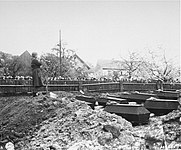
Flossenbürg concentration camp
Flossenbürg was a Nazi concentration camp built in May 1938 by the SS Main Economic and Administrative Office. Unlike other concentration camps, it was located in a remote area, in the Fichtel Mountains of Bavaria, adjacent to the town of Flossenbürg and near the German border with Czechoslovakia. The camp's initial purpose was to exploit the forced labor of prisoners for the production of granite for Nazi architecture. In 1943, the bulk of prisoners switched to producing Messerschmitt Bf 109 fighter planes and other armaments for Germany's war effort. Although originally intended for "criminal" and "asocial" prisoners, after Germany's invasion of the Soviet Union, the camp's numbers swelled with political prisoners from outside Germany. It also developed an extensive subcamp system that eventually outgrew the main camp.
"Flossenbürg" redirects here. For the town, see Flossenbürg, Bavaria.Flossenbürg
Flossenbürg, Bavaria, Germany
- Jakob Weiseborn (May 1938 – January 1939)
- Karl Künstler (January 1939 – July 1942)
- Karl Fritzsch (July–September 1942)
- Egon Zill (September 1942 – April 1943)
- Max Koegel (April 1943 – April 1945)
3 May 1938 – 23 April 1945
Political prisoners, Jews, criminals, antisocials
89,974
c. 30,000
Before it was liberated by the United States Army in April 1945, 89,964 to 100,000 prisoners passed through Flossenbürg and its subcamps. Around 30,000 died from malnutrition, overwork, executions, or during the death marches. Some of those responsible for these deaths, including administrators, guards, and others, were tried and convicted in the Flossenbürg trial. The camp was repurposed for other uses before the opening of a memorial and museum in 2007.
On 14 April 1945, SS leader Heinrich Himmler ordered all of the camps to be evacuated: "Not a single prisoner must fall alive into enemy hands".[83] As soon as he received the order, Koegel sent some families of SS men away and prepared to evacuate the camp.[76] At 5 am on 16 April, the 1,700 Jewish prisoners at Flossenbürg main camp were separated from the rest and ordered to assemble. Eight SS men guarded each column of 100 prisoners. When they reached the railway station, 4 miles (6.4 km) distant, they were loaded into closed and open freight cars, 60 to 75 each.[84] The train was strafed by United States aircraft soon after setting out, causing the guards to flee temporarily. Many prisoners were injured or killed; others rummaged for food that the SS guards had left behind. After the raid, the guards returned and shot injured prisoners. The total number of deaths was several dozen, increasing in the next two days as the prisoners were not provided with food or water.[85]
The route proceeded by rail through Neunburg vorm Wald, Weiden in der Oberpfalz, Pfreimd, Nabburg, and Schwarzenfeld, where, on 19[86] or 20 April, about 750 of the Jewish prisoners were stranded after another aerial attack disabled the locomotive. The SS murdered any prisoners who were unable to continue the march on foot. After the liberation, 140 corpses were found in a nearby field; some of the victims had been killed in the air raid, while others had been murdered. One prisoner testified that "The SS men joked and laughed during the shooting ... the prisoners were led in groups of 15–20, they had to lie on the ground and were shot in the nape".[87] The survivors were divided into columns 100-strong and marched through heavy rain and mud. Many were ill with fever, but anyone unable to keep up was shot on the spot.[88] At Neukirchen-Balbini, the death march joined up with the larger one of non-Jewish prisoners.[89] Another group of Jewish evacuees continued towards Theresienstadt, arriving in early May.[90]
Evacuation of non-Jewish prisoners began on 17 April, when 2,000 prisoners left on foot, arriving at Dachau on 23 April. This group consisted of longtime Flossenbürg prisoners, a group from Ohrdruf concentration camp, and the survivors of the death march from Buchenwald.[84] SS official Kurt Becher, who was involved in negotiations between Himmler and the Allies, visited Flossenbürg on 17 April and attempted to persuade Koegel not to evacuate the camp.[91] A telegram from Himmler the next day repeated the order not to let any prisoner fall into enemy hands.[91][74] On 19 April, some 25,000 to 30,000 remaining prisoners in Flossenbürg and its subcamps were ordered to evacuate to Dachau.[91] About 16,000 prisoners actually set out, and only a few thousand reached their destination.[92] The prisoners were transported by rail to Oberviechtach, where they split into two groups. One of these traveled by foot and in trucks via Külz, Dieterskirchen, and Schwarzhofen, joining the earlier march of Jewish prisoners in Neunburg. Many prisoners remained in the town from 20–22 April, when the SS guards deserted. The United States Army arrived in the area on 23 April and found 2,500 surviving prisoners. Many others were liberated on the road to Cham, 34 kilometres (20 mi) to the southeast.[86]
At many of Flossenbürg's subcamps, the SS massacred sick Jewish prisoners before evacuating. Including these massacres, the death marches cost the lives of about 7,000 prisoners from Flossenbürg and its subcamps.[92] The 90th Infantry Division[93] of the United States Army liberated the main camp on 23 April and found 1,527 ill and weak prisoners in the camp hospital;[36][91] more than 100 prisoners had died in the preceding three days. Despite the efforts of American medics, only 1,208 prisoners survived the immediate aftermath of liberation. Initially, the American authorities ordered the bodies to be burned in the camp crematorium, but after protests from the survivors, held a funeral for 21 former prisoners on 3 May.[64] Some of Flossenbürg's eastern subcamps, located east of the demarcation line, were liberated by the Red Army.[94]



